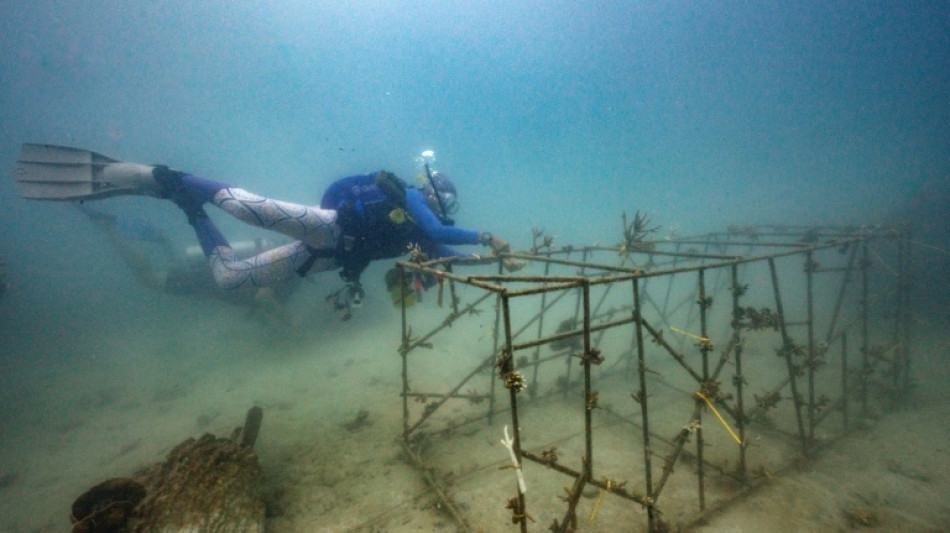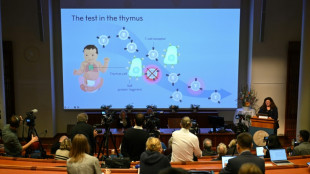
-
 Unreachable Nobel winner hiking 'off the grid'
Unreachable Nobel winner hiking 'off the grid'
-
Retirement or marketing gimmick? Cryptic LeBron video sets Internet buzzing

-
 CAF 'absolutely confident' AFCON will go ahead in protest-hit Morocco
CAF 'absolutely confident' AFCON will go ahead in protest-hit Morocco
-
Paris stocks slide amid French political upheaval, Tokyo soars

-
 EU should scrap ban on new combustion-engine sales: Merz
EU should scrap ban on new combustion-engine sales: Merz
-
US government shutdown enters second week, no end in sight

-
 World MotoGP champion Marquez to miss two races with fracture
World MotoGP champion Marquez to miss two races with fracture
-
Matthieu Blazy reaches for the stars in Chanel debut

-
 Macron gives outgoing French PM final chance to salvage government
Macron gives outgoing French PM final chance to salvage government
-
Illinois sues to block National Guard deployment in Chicago

-
 Exiled Willis succeeds Dupont as Top 14 player of the season
Exiled Willis succeeds Dupont as Top 14 player of the season
-
Hamas and Israel open talks in Egypt under Trump's Gaza peace plan

-
 Mbappe undergoing treatment for 'small niggle' at France camp: Deschamps
Mbappe undergoing treatment for 'small niggle' at France camp: Deschamps
-
Common inhalers carry heavy climate cost, study finds

-
 Madagascar president taps general for PM in bid to defuse protests
Madagascar president taps general for PM in bid to defuse protests
-
UEFA 'reluctantly' approves European league games in US, Australia

-
 Hundreds protest in Madagascar as president to announce new premier
Hundreds protest in Madagascar as president to announce new premier
-
Greta Thunberg lands in Greece among Gaza flotilla activists deported from Israel

-
 UNESCO board backs Egyptian ex-minister for top job: official
UNESCO board backs Egyptian ex-minister for top job: official
-
Facing confidence vote, EU chief calls for unity

-
 Cash-strapped UNHCR shed 5,000 jobs this year
Cash-strapped UNHCR shed 5,000 jobs this year
-
Mbappe to have 'small niggle' examined at France camp: Deschamps

-
 Brazil's Lula asks Trump to remove tariffs in 'friendly' phone call
Brazil's Lula asks Trump to remove tariffs in 'friendly' phone call
-
'Terrible' Zverev dumped out of Shanghai by France's Rinderknech

-
 What are regulatory T-cells? Nobel-winning science explained
What are regulatory T-cells? Nobel-winning science explained
-
OpenAI signs multi-billion dollar chip deal with AMD

-
 Salah under fire as Liverpool star loses his spark
Salah under fire as Liverpool star loses his spark
-
Paris stocks drop as French PM resigns, Tokyo soars

-
 ICC finds Sudan militia chief guilty of crimes against humanity
ICC finds Sudan militia chief guilty of crimes against humanity
-
Zverev dumped out of Shanghai Masters by France's Rinderknech

-
 One hiker dead, hundreds rescued after heavy snowfall in China
One hiker dead, hundreds rescued after heavy snowfall in China
-
Hundreds stage fresh anti-government protests in Madagascar

-
 Feminist icon Gisele Pelicot back in court as man appeals rape conviction
Feminist icon Gisele Pelicot back in court as man appeals rape conviction
-
US government shutdown enters second week

-
 Kasatkina ends WTA season early after hitting 'breaking point'
Kasatkina ends WTA season early after hitting 'breaking point'
-
Paris stocks drop as French PM resigns

-
 Death toll from Indonesia school collapse rises to 63
Death toll from Indonesia school collapse rises to 63
-
Medicine Nobel to trio who identified immune system's 'security guards'

-
 UN rights council launches probe into violations in Afghanistan
UN rights council launches probe into violations in Afghanistan
-
UK author Jilly Cooper dies aged 88

-
 Jilly Cooper: Britain's queen of the 'bonkbuster' novel
Jilly Cooper: Britain's queen of the 'bonkbuster' novel
-
Streaming stars' Le Mans race scores Twitch viewer record

-
 England rugby star Moody 'shocked' by motor neurone disease diagnosis
England rugby star Moody 'shocked' by motor neurone disease diagnosis
-
Leopard captured after wandering into Indonesian hotel

-
 Israel, Hamas due in Egypt for ceasefire talks
Israel, Hamas due in Egypt for ceasefire talks
-
Rescuers scramble to deliver aid after deadly Nepal, India floods

-
 Tokyo stocks soar on Takaichi win, Paris sinks as French PM resigns
Tokyo stocks soar on Takaichi win, Paris sinks as French PM resigns
-
OpenAI offers more copyright control for Sora 2 videos

-
 Australia prosecutors appeal 'inadequate' sentence for mushroom murderer: media
Australia prosecutors appeal 'inadequate' sentence for mushroom murderer: media
-
Rugby World Cup-winning England star Moody has motor neurone disease


How restoration can help coral reefs
Record-high sea temperatures are bleaching coral reefs worldwide and putting a new focus on attempts to restore these key marine ecosystems.
Here is an overview of how coral restoration is being done around the world:
- How is coral sourced? -
Restoration begins with obtaining coral, sometimes by breaking it off from a healthy reef. These pieces can be broken into smaller bits in a process called microfragmentation.
Each piece can become a new coral.
Another option involves collecting "fragments of opportunity" -- coral pieces broken off by natural causes such as storms.
Conservationists can also propagate from egg bundles collected during reef spawning, though this is perhaps the most difficult approach.
Spawning is brief, generally happening just once a year, and is affected by many factors, including the lunar phase and water temperature.
- What happens next? -
Coral microfragments generally go into a "nursery" until they grow sturdy enough to be transplanted to an existing reef or an artificial structure.
Fragments of opportunity are treated similarly. If big enough, they can be transplanted directly to natural or artificial reefs.
Bundles of coral eggs and sperm collected during spawning will develop into larvae that can then be settled onto reefs or, more commonly, grown on artificial foundations before being transplanted to their final homes.
- What else is involved? -
Other techniques are used to bolster coral restoration, including mineral accretion technology.
This involves sending a low-voltage electrical current through seawater to encourage minerals to dissolve and crystallise on artificial reef structures, speeding up coral growth.
The technique has had mixed results, with some studies reporting better growth and more resilient corals, but others finding no significant benefits.
Other interventions include substrate stabilisation, which shores up reef foundations, and algae removal.
- What corals are used? -
Restoration projects heavily favour quick-growing branching corals.
The delicate branches of these corals are more susceptible to becoming fragments of opportunity, and are also easier to microfragment than massive or encrusting corals.
Their fast-growing nature gives restoration projects quicker results, though focusing on only one type of coral can reduce ecosystem diversity.
- Does it work? -
Coral restoration projects report survival rates of around 60-70 percent, according to a study published in 2020.
But around half the projects in the study failed to properly measure whether they achieved the goals stated at the outset, including reef function.
Monitoring was also often brief, at a median of just one year, far less than the time needed for a reef to form, according to the authors.
Still, the projects can produce real benefits.
A 2024 study of artificial reefs in Indonesia found that within four years the structures had a coral carbonate budget -- a measure of reef wellbeing -- that was nearly equal to nearby healthy natural reef.
- What are other considerations? -
Some experts worry that coral restoration is too often presented as panacea for reviving reefs, and point out that transplants will only survive if the surrounding conditions are right.
That means first addressing climate change, which causes the warm temperatures that lead to coral bleaching.
"Well-designed and managed restoration projects have an important role to play, but there is only so much they can do if radical action on the climate is not taken almost immediately," warned Lisa Bostrom-Einarsson, the marine ecologist who led the 2020 study.
And other stressors, from blast fishing to sedimentation, must also be tackled for reefs to have a future.
Reef restoration also rarely offers a one-for-one replacement of destroyed ecosystems.
The Indonesia reefs examined in the 2024 study are still largely made up of transplanted corals, with little sign yet that "natural recruits" are taking root and building reef diversity.
Building reefs through microfragmentation also limits genetic diversity and can put reefs at risk if disease takes hold.
Still, well-done restoration offers considerable benefits, including coastal protection and boosting marine life.
That also helps local communities dependent on fishing or tourism.
"Restoration will not save corals at the current rate we're losing them," said Gavin Miller, a marine scientist with the Global Reef organisation in Thailand.
"It's more about these localised impacts and the scale and the awareness that you can raise from there."
G.Frei--VB


